Missouri is home to various bird species, ranging from common backyard birds to rare and endangered species.
From the tufted titmouse to the bald eagle, birds of Missouri provide important ecological services and add beauty to the state’s natural landscapes.
With over 400 species of birds, Missouri has something for everyone to enjoy.
This introduction will provide an overview of the bird species that call Missouri home, their habitats, and their important roles in the state’s ecosystems.
48 Birds Of Missouri
Are you a bird lover who lives in Missouri or plans to visit the state soon? If so, you might be interested in learning about some of the amazing birds found there. Missouri is home to over 400 species of birds, from common backyard visitors to rare and endangered ones.
Here are 48 birds commonly found in Missouri
1. Northern Cardinal
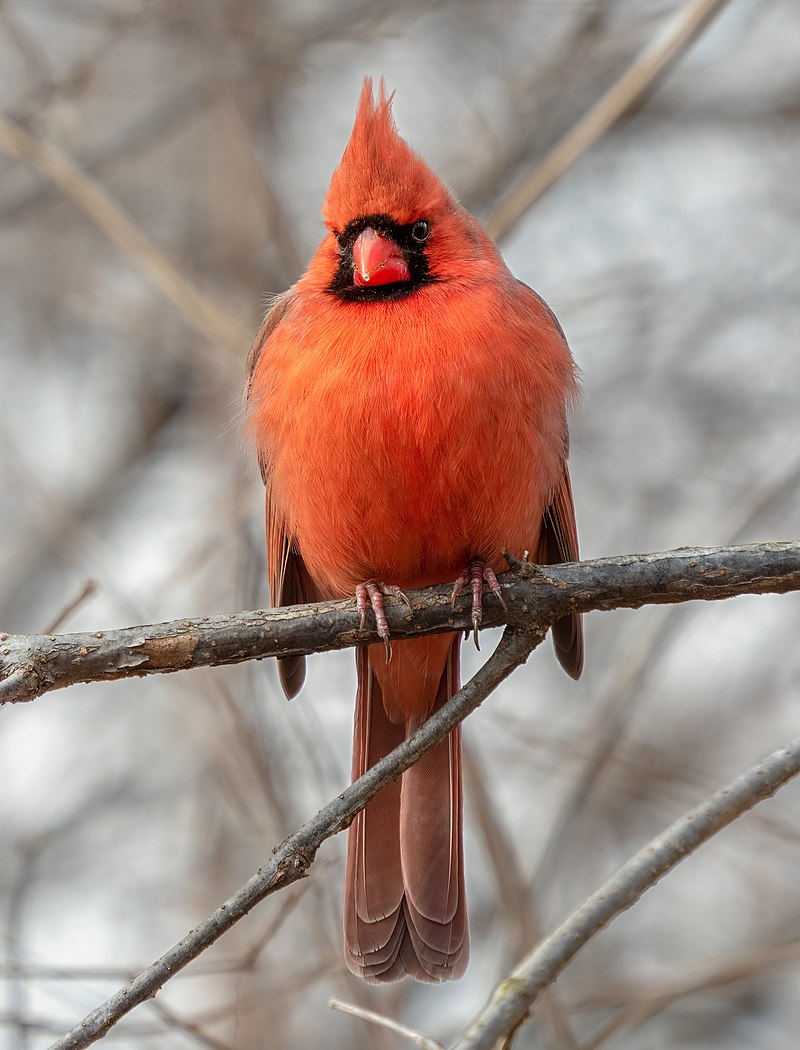
The Northern Cardinal is a beautiful bird, easily identified by its bright red plumage. It can be found in the eastern United States from Maine to Minnesota and south through Mexico and Belize.
Along with its striking coloration, it has a distinctive crest on its head and sharp black facial markings around the eyes.
Despite their small size (7-9 inches), they are very vocal birds – males sing persistently throughout springtime to attract mates or proclaim their territory.
They typically feed on insects, seeds, and fruits but enjoy suet at backyard bird feeders.
The female is less brightly colored than her mate but still stands out among other songbirds due to her warm brownish-red feathers.
Cardinals pair for life, so you may often see them together in your garden or neighborhood park.
Scientific classification:
| Kingdom | Animalia |
| Phylum | Chordata |
| Class | Aves |
| Order | Passeriformes |
| Family | Cardinalidae |
| Genus | Cardinalis |
| Species | C. cardinalis |
2. Eastern Bluebird
The Eastern bluebird is a small migratory thrush in North America’s open woodlands, farms, and orchards.
The male has bright-blue breeding plumage, which makes it easily recognizable by birders.
It produces melodious songs such as jeew, chair-wi, and chili WEEW widow.
This popular species was declared the state bird of Missouri back in 1927 due to its beauty and charm.
In addition to being beautiful, these birds are also beneficial for farmers because they eat insects like grasshoppers and beetles, which damage crops.
They nest in cavities, so providing nesting boxes helps them thrive even more.
With their vibrant colors, sweet melodies, and helpful nature, it’s easy to see why the Eastern Bluebird is beloved worldwide.
Scientific classification:
| Kingdom | Animalia |
| Phylum | Chordata |
| Class | Aves |
| Order | Passeriformes |
| Family | Turdidae |
| Genus | Sialia |
| Species | S. sialis |
3. American Goldfinch
The American goldfinch is a small North American bird in the finch family. Males are vibrant yellow with black wings and tails, while females are duller in coloration.
It migrates from mid-Alberta to North Carolina during the breeding season, south of Canada–United States border to Mexico for its wintering grounds.
The only finch that undergoes complete molt every year displays sexual dichromatism, where males have brighter colors than their female counterparts.
They feed mainly on seeds but also eat insects such as aphids and caterpillars when raising young; they often occur near thistles or other plants that produce viable seed heads.
Their call consists of various chirps and trills, making them quite conspicuous.
Scientific classification:
| Kingdom | Animalia |
| Phylum | Chordata |
| Class | Aves |
| Order | Passeriformes |
| Family | Fringillidae |
| Subfamily | Carduelinae |
| Genus | Spinus |
| Species | S. tristis |
4. American Robin

The American robin is a migratory bird belonging to the true thrush genus and Turdidae family.
It was named after its European counterpart due to the similar reddish-orange breast they possess; however, they are not closely related.
This species can be seen through most of North America during winter and in parts of Mexico and Central America, where it also breeds.
They have plump bodies with gray upperparts and white underparts that vary from yellow on their throats down to orange toward their bellies.
Robins feed on fruits such as berries or insects like worms, making them an important part of ecosystems by helping disperse seeds naturally throughout these areas.
Scientific classification:
| Kingdom | Animalia |
| Phylum | Chordata |
| Class | Aves |
| Order | Passeriformes |
| Family | Turdidae |
| Genus | Turdus |
| Species | T. migratorius |
5. House Finch

The House Finch is a finch species native to western North America and has been introduced in the eastern half of the continent and Hawaii.
It’s an average-sized finch with adults measuring 12.5 – 15 cm (5 – 6 inches) long and wingspan between 20 – 25 cm (8 – 10 inches).
The upperparts are brown, while its underparts range from pale grayish white to yellow depending on subspecies.
Its face is streaked or spotted with reddish coloration; males typically have brighter plumage than females due to sexual dimorphism.
They’re mostly found near human habitations such as farms and gardens, where they feed on grains, fruits, insects, etc., making them very popular among birders who want something colorful for their backyard.
Scientific classification:
| Kingdom | Animalia |
| Phylum | Chordata |
| Class | Aves |
| Order | Passeriformes |
| Family | Fringillidae |
| Subfamily | Carduelinae |
| Genus | Haemorhous |
| Species | H. mexicanus |
6. Downy Woodpecker
The downy woodpecker is a small species of woodpecker found in North America. Growing up to 7 inches long, it can be identified by its white belly and spotted wings.
It inhabits forests throughout the United States and Canada, except deserts in the southwest and northern tundra.
This bird nests in tree cavities and feeds mostly on insects but will supplement its diet with fruit or nuts when available.
The Downy Woodpecker has an unmistakable call that sounds like a loud ‘piker,’ similar to other members of its family, such as the Hairy Woodpecker.
Scientific classification:
| Kingdom | Animalia |
| Phylum | Chordata |
| Class | Aves |
| Order | Piciformes |
| Family | Picidae |
| Genus | Dryobates |
| Species | D. pubescens |
7. White-Breasted Nuthatch
The White-breasted Nuthatch is a medium-sized bird belonging to the nuthatch family Sittidae. It measures around 15.5 cm long, and its color varies throughout its range.
Males have a light blue-grey upperpart, with a black crown and nape, whereas females have a dark grey crown instead of a black one.
The underparts are whitish, with reddish tinge on sides and flanks while the bill is short and stout with pale base near eyes which can be yellow or white depending upon geographic location..
This species feeds mainly on insects but will also eat seeds, nuts, and berries when available.
They prefer open woodlands where they often climb trees searching for food along trunks and branches underneath bark crevices, creating their nest there, too.
Scientific classification:
| Kingdom | Animalia |
| Phylum | Chordata |
| Class | Aves |
| Order | Passeriformes |
| Family | Sittidae |
| Genus | Sitta |
| Species | S. carolinensis |
8. Dark-Eyed Junco

The Dark-eyed Junco is a species of small, grayish sparrows found across much of temperate North America and in the Arctic during summer.
Carl Linnaeus formally described it in 1766 and named it after its distinctive dark eyes.
This bird has a very variable appearance due to the many different subspecies it contains, making its systematics difficult to unravel.
The plumage varies from white or light gray on their underparts with slate grey backs and wings, black heads with white outer tail feathers, brown head stripes, yellow bills, pink legs, and feet, as well as various shades between all these colors.
They also have considerable sexual dimorphism, where males tend to be more colorful than females but share similar characteristics such as short tails and rounded bodies – both sexes being around 16 cm long when fully grown.
Scientific classification:
| Kingdom | Animalia |
| Phylum | Chordata |
| Class | Aves |
| Order | Passeriformes |
| Family | Passerellidae |
| Genus | Junco |
| Species | J. hyemalis |
9. Black-Capped Chickadee
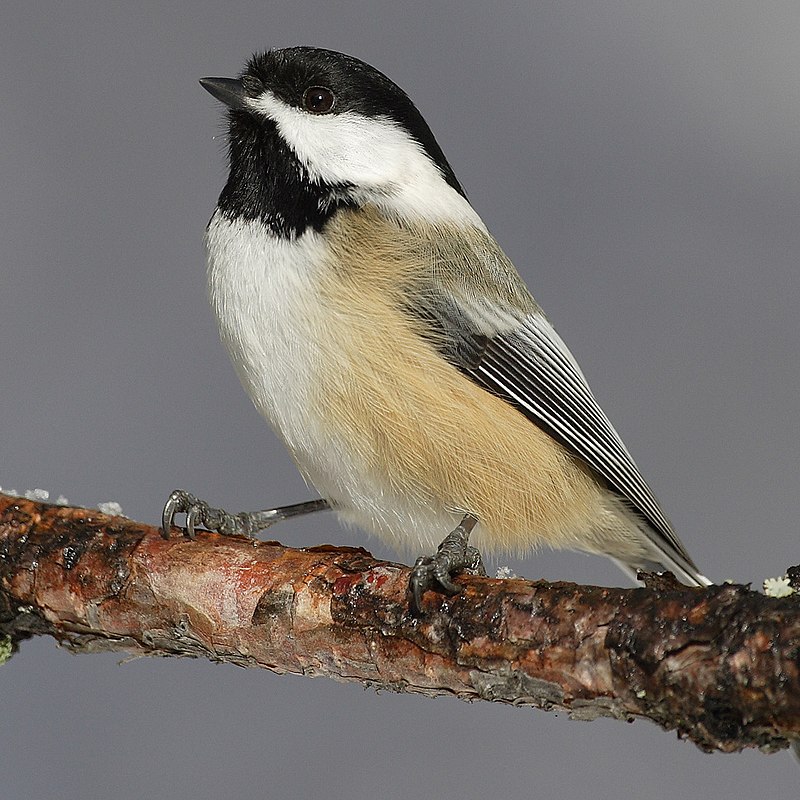
The black-capped chickadee is a small, cheerful songbird in deciduous and mixed forests across North America. It has an iconic black cap, white cheeks, gray back, and wings with whitish bars.
The underparts are usually light-colored or greyish-brown. This species is well adapted to cold winters as it can reduce its body temperature by up to 8°C while roosting at night; this helps save energy during the year’s colder months.
It feeds mainly on insects but eats seeds, fruits, and suet from bird feeders when available.
Black-capped chickadees are popular birds among backyard visitors due to their sociable nature – they often establish lifelong partnerships with one another for breeding purposes.
Furthermore, they have been designated as state birds of Massachusetts and Maine in the USA and New Brunswick in Canada – a testament to how beloved these little avian friends are.
Scientific classification:
| Kingdom | Animalia |
| Phylum | Chordata |
| Class | Aves |
| Order | Passeriformes |
| Family | Paridae |
| Genus | Poecile |
| Species | P. atricapillus |
10. Blue Jay
The Blue Jay is a beautiful bird residing in the eastern and central United States and Newfoundland, Canada.
They have an unmistakable blue plumage with white markings on their heads and wings.
These birds are highly adaptable to habitats ranging from deciduous forests to urban areas.
As part of the Corvidae family, they are known for being intelligent problem solvers who often use tools or mimic vocalizations of other species, like hawks, when defending their territories.
Their diet consists mostly of insects, seeds, and nuts but can also include small vertebrates such as frogs or lizards if food resources become scarce.
Overall, these birds provide much-needed color to our environment while playing important roles in maintaining healthy ecosystems through pollination services and seed dispersal activities.
Scientific classification:
| Kingdom | Animalia |
| Phylum | Chordata |
| Class | Aves |
| Order | Passeriformes |
| Family | Corvidae |
| Genus | Cyanocitta |
| Species | C. cristata |
11. Common Starling

The Common Starling is a medium-sized passerine bird that belongs to the Starling family. It has glossy black plumage with a metallic sheen; at certain times of the year, it can be speckled with white.
The bill and legs are typically pink or black depending on the season, while its length measures about 8 inches long.
Its diet consists mainly of insects but includes small fruits, seeds, and human food waste.
They live in large flocks, which protects predators, although they can become quite aggressive when defending their nesting sites during breeding seasons.
Overall, this species is highly adaptable and widely distributed across many parts of Europe, making them one of the most successful birds in the region today.
Scientific classification:
| Kingdom | Animalia |
| Phylum | Chordata |
| Class | Aves |
| Order | Passeriformes |
| Family | Sturnidae |
| Genus | Sturnus |
| Species | S. vulgaris |
12. Brown-Headed Cowbird
The Brown-headed Cowbird is a small, obligate brood parasitic icterid native to temperate and subtropical North America. It has a brown head with glossy black plumage on the body, wings, and tail feathers.
During summer, they can be found in prairies, grasslands, and open wooded areas, but during winter, they migrate southwards towards the United States of Mexico for warmer climates.
They are mainly insectivorous birds that feed on insects like caterpillars or beetles but consume some grains.
The female bird lays its eggs in nests of other species and then incubates them until hatching time, thus leaving their chicks uncared for.
Scientific classification:
| Kingdom | Animalia |
| Phylum | Chordata |
| Class | Aves |
| Order | Passeriformes |
| Family | Icteridae |
| Genus | Molothrus |
| Species | M. ater |
13. Mourning Dove
The Mourning Dove is a breathtakingly beautiful bird. It has stunning gray and brown feathers with white-tipped wings, giving it an elegant appearance. Its long tail also adds to its graceful look in flight.
A symbol of peace and serenity, they are abundant across North America and can be found in gardens or open fields throughout the year.
As well as being popular game birds for hunters, they feed on grains such as wheat and millet, providing important food sources for wildlife species, including foxes, coyotes, skunks, and raccoons.
These doves have a distinctive cooing sound that can often echo through woodlands during summer evenings, making them one of nature’s greatest treasures.
Scientific classification:
| Kingdom | Animalia |
| Phylum | Chordata |
| Class | Aves |
| Order | Columbiformes |
| Family | Columbidae |
| Genus | Zenaida |
| Species | Z. macroura |
14. Tufted Titmouse
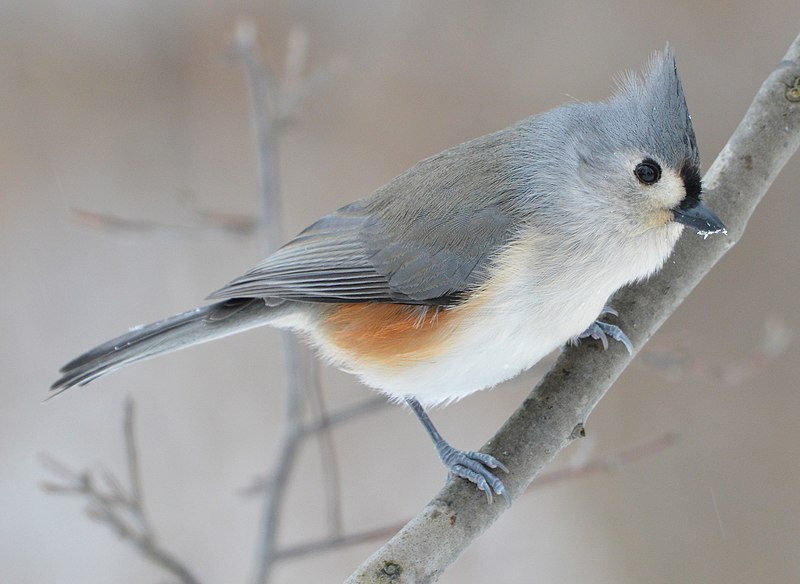
The Tufted Titmouse is a small, cheerful songbird found in North America. It’s part of the tit and chickadee family (Paridae).
It has distinctive white feathers around its eyes, grey-brown wings, and upper body, with a pale tan underside.
Its most notable feature is the black crest on top of its head, which gives it an inquisitive look. The male also sports a pinkish breast, which can be seen.
When singing from high perches during the spring months. This bird loves to eat sunflower seeds or suet at backyard feeders and insects in summertime.
You may even see them poking into crevices and bark, looking for food.
They are quite social birds, too, being often spotted in mixed flocks alongside other species, such as nuthatches and woodpeckers, all year round.
Scientific classification:
| Kingdom | Animalia |
| Phylum | Chordata |
| Class | Aves |
| Order | Passeriformes |
| Family | Paridae |
| Genus | Baeolophus |
| Species | B. bicolor |
15. Wrens
Wrens are a family of small brown passerine birds found mainly in the Americas. They are considered one of the most abundant bird species, with 88 known varieties divided into 19 genera.
The Eurasian wren is the only type inhabiting Europe and other parts of the Old World, commonly referred to simply as “wren.”
This species has been given its name due to similar-looking unrelated birds living elsewhere, such as New Zealand wrasses.
Wrens have tiny bodies with thin bills and long tails, which they often hold upright for hours while singing their loud, cheery songs from treetops or low shrubs.
Their diet consists mostly of insects but can also include fruits and seeds depending on availability in their habitat range.
Scientific classification:
| Kingdom | Animalia |
| Phylum | Chordata |
| Class | Aves |
| Order | Passeriformes |
| Superfamily | Certhioidea |
| Family | Troglodytidae Swainson, 1832 |
16. White-Throated Sparrow
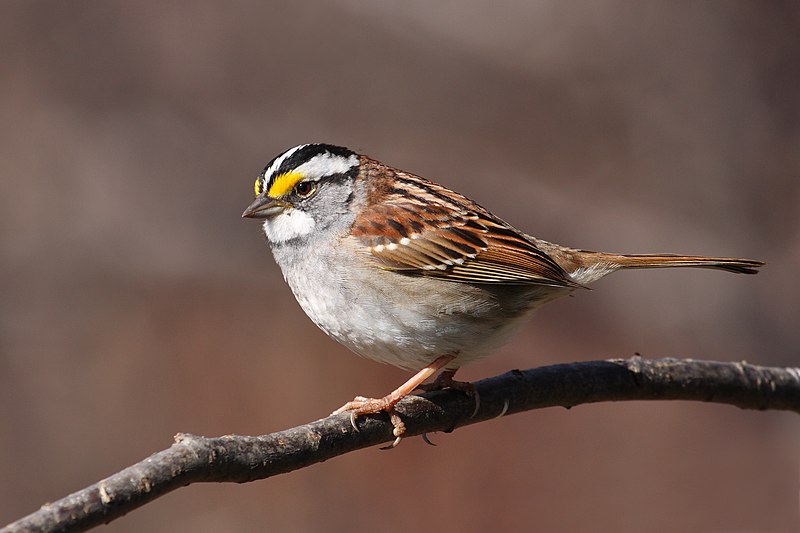
The White-throated Sparrow is a small passerine bird of the New World sparrow family, Passerellidae.
It has distinctive yellow and black stripes on its head, white throat and chest, grey back and wings, and light brown legs.
The scientific name “Zonotrichia albicollis” comes from Ancient Greek for ‘band’ (ζώνη), referring to its distinctive striped crown, and Latin for ‘white neck’ (albus collum).
These birds are usually found in wooded areas such as coniferous forests or deciduous habitats in North America, where they feed mainly on insects during the summer months, transitioning to seeds during winter.
They build their nests near ground level using grasses, twigs, or moss lined with feathers.
White-throated Sparrows may be solitary but also form flocks when migrating southward each fall season, which typically occurs over mid-late October through November, depending on location within range.
Scientific classification:
| Kingdom | Animalia |
| Phylum | Chordata |
| Class | Aves |
| Order | Passeriformes |
| Family | Passerellidae |
| Genus | Zonotrichia |
| Species | Z. albicollis |
17. Carolina Wren
The Carolina wren (Thryothorus ludovicianus) is a medium-sized bird in the eastern United States, southern Ontario, and northeast Mexico.
They typically live in dense shrubbery or thickets near open areas such as gardens, parks, and woodland edges.
These birds are quite adaptable in nesting sites – they will build their nests anywhere from tree cavities to manmade boxes.
Their diet consists of insects, spiders, and other invertebrates, which they forage for on the ground or among vegetation.
The males have an unmistakable song of loud whistles interspersed with trills reminiscent of laughter; you’ll often find these cheerful little birds singing away during the early morning hours.
Scientific classification:
| Kingdom | Animalia |
| Phylum | Chordata |
| Class | Aves |
| Order | Passeriformes |
| Family | Troglodytidae |
| Genus | Thryothorus Vieillot, 1816[2] |
| Species | T. ludovicianus |
18. Red-Winged Blackbird

The red-winged blackbird is a beautiful bird found in most of North America and Central America.
Its distinct features include a glossy black body, white shoulder patches, and bright red wing coverts year round.
It prefers wetland habitats such as marshes, ponds, lakeshores, and agricultural fields. During breeding season, they inhabit grassy areas near water, then move south for the winter months.
For food, they mainly eat insects but also consume wild fruit or grains.
They are very social birds, often seen in large flocks during migration when their unmistakable “conk-la-ree” call can be heard echoing across the sky.
Scientific classification:
| Kingdom | Animalia |
| Phylum | Chordata |
| Class | Aves |
| Order | Passeriformes |
| Family | Icteridae |
| Genus | Agelaius |
| Species | A. phoeniceus |
19. Carolina Chickadee
The Carolina Chickadee is a small passerine bird found in the tit family Paridae. It stands out for its distinct black and white, grey-brown feathers with an off-white underside.
This species can be spotted by its call: “chick-a-dee.” The American Ornithologists’ Union has classified them into their genus called Poecile, as they differ from other tits due to both genetic data and morphology.
These birds live in wooded areas near open fields or water sources all over North America.
They feed on insects such as caterpillars but have also been known to eat suet at backyard feeders during winter when food is scarce.
Scientific classification:
| Kingdom | Animalia |
| Phylum | Chordata |
| Class | Aves |
| Order | Passeriformes |
| Family | Paridae |
| Genus | Poecile |
| Species | P. carolinensis |
20. Red-bellied woodpecker
The Red-bellied woodpecker is a beautiful bird with an orange-red crown and nape. It breeds mainly in the eastern United States, from Florida to Canada.
This medium-sized woodpecker of the family Picidae has black wings, white stripes on its back, and tail feathers barred with black.
Its underside is mostly pale yellow or white, but it has red coloration around its neck.
Despite this subtle red hue, it should not be mistaken for the entirely red head and neck belonging to the Red-headed woodpecker of the same genus, Melanerpes carolinus.
The Red-bellied Woodpeckers’ diet consists primarily of insects such as ants, beetles, grasshoppers, nuts, fruits, berries, and tree sap, which they will feed upon at different times throughout their life cycle.
Scientific classification:
| Kingdom | Animalia |
| Phylum | Chordata |
| Class | Aves |
| Order | Piciformes |
| Family | Picidae |
| Genus | Melanerpes |
| Species | M. carolinus |
21. Purple Finch
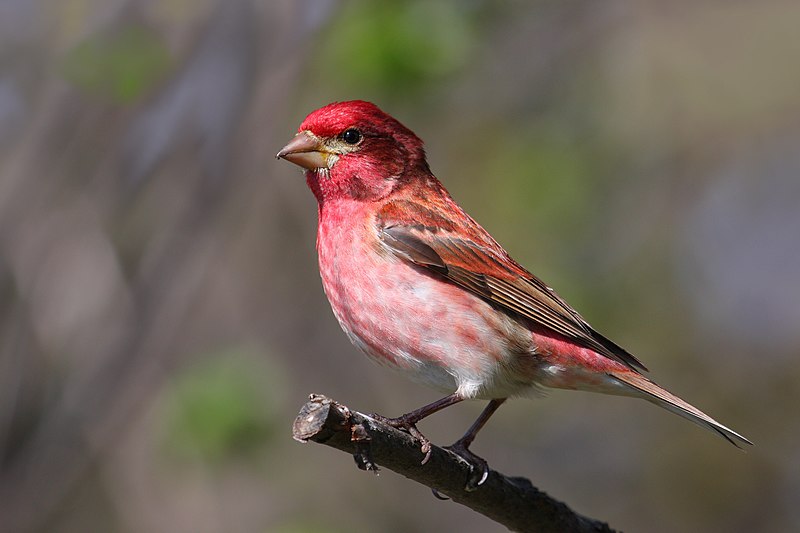
The Purple Finch is a species of finch from North America belonging to the Fringillidae family.
It’s also known as an “American Rosefinch” due to its resemblance in color and size to some European rosefinches.
Their plumage ranges from pinkish-purple on their heads and wings with a light brown underside.
Small birds measure about 5-6 inches long with short, thin beaks for eating seeds and insects.
In addition, they have thick, round bodies, which help them stay warm during cold winters in the northern parts of their range.
The Purple Finch has adapted well over time, making it easier for them to survive despite increasing threats posed by humans, such as deforestation or habitat destruction caused by development projects near their habitats.
Scientific classification:
| Kingdom | Animalia |
| Phylum | Chordata |
| Class | Aves |
| Order | Passeriformes |
| Family | Fringillidae |
| Subfamily | Carduelinae |
| Genus | Haemorhous |
| Species | H. purpureus |
22. Ruby-Throated Hummingbird
The ruby-throated hummingbird (Archilochus colubris) is a hummingbird species with an impressive migration pattern, spending the winter in Central America, Mexico, and Florida before flying to Canada and other parts of Eastern North America for the breeding season.
It’s the most common type seen east of the Mississippi River in North America.
Formally described by Swedish naturalist Carl Linnaeus in 1758, this tiny bird has bright metallic green upperparts with white underparts, a small black bill, and a red throat patch, which gives it its name; they measure around 3 inches long on average.
They feed primarily on nectar from flowers but eat insects such as flies or mosquitoes for extra protein during their migrations or when raising young chicks.
Scientific classification:
| Kingdom | Animalia |
| Phylum | Chordata |
| Class | Aves |
| Order | Apodiformes |
| Family | Trochilidae |
| Genus | Archilochus |
| Species | A. colubris |
23. Common Yellowthroat
The Common Yellowthroat is a small New World Warbler found throughout North America. It has distinctive yellow and black plumage, earning it the nickname “Yellow Bandit” in the Midwest United States.
This highly adaptable species inhabits wetlands, grasslands, shrubland habitats, and suburban areas.
The genus of this bird’s scientific name means ‘ground’ and ‘small bird,’ which are fitting characteristics for such an elusive yet common little creature.
Its diet consists predominantly of insects but may also include other invertebrates like spiders or worms.
Overall, its cheerful song makes the Common Yellowthroat an excellent addition to any backyard.
Scientific classification:
| Kingdom | Animalia |
| Phylum | Chordata |
| Class | Aves |
| Order | Passeriformes |
| Family | Parulidae |
| Genus | Geothlypis |
| Species | G. trichas |
24. Red-Headed Woodpecker
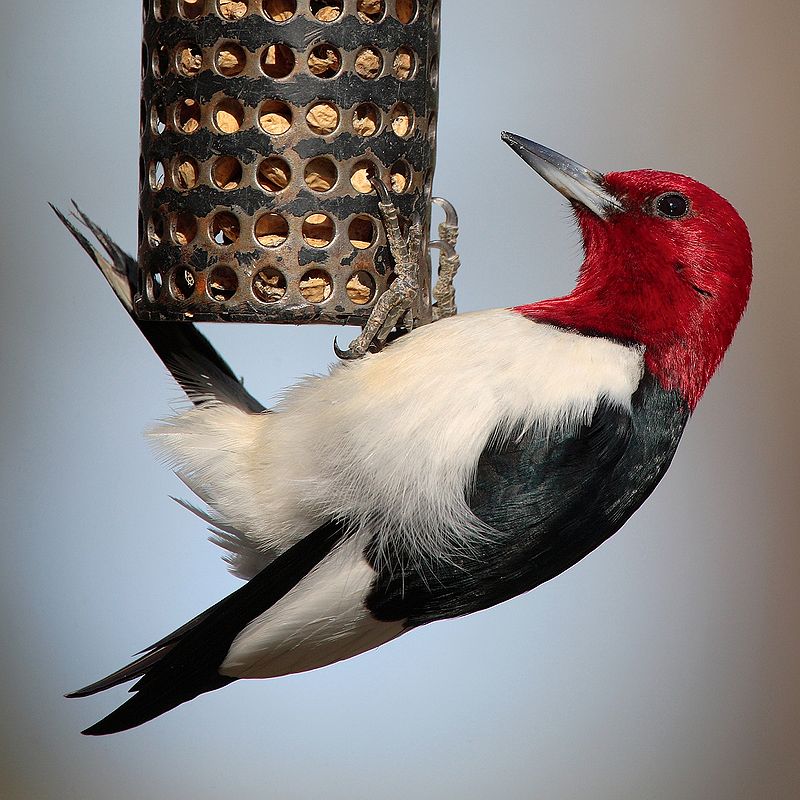
The red-headed woodpecker is a mid-sized bird found in temperate North America. It has striking plumage, with its head and neck bright red, while the rest of its body is primarily black and white.
Its wings are rounder than those of similar species, allowing it to maneuver through tight spaces easily when searching for food or shelter.
The breeding habitat of this bird consists mainly of open fields across Canada and the east-central United States.
Despite facing threats such as deforestation, urbanization, predation from larger birds, and collisions with windows or cars due to their inquisitive nature.
These birds remain listed on IUCN’s Red List as the least concerned, thanks largely to conservation efforts by local governments and organizations dedicated to protecting wildlife habitats.
Scientific classification:
| Kingdom | Animalia |
| Phylum | Chordata |
| Class | Aves |
| Order | Piciformes |
| Family | Picidae |
| Genus | Melanerpes |
| Species | M. erythrocephalus |
25. Baltimore Oriole
The Baltimore Oriole is a small, blackbird-like bird in eastern North America. It’s named for the resemblance of its male colors to those on Lord Baltimore’s coat-of-arms from the 17th century.
These birds migrate and breed during springtime and are quite common in their habitats.
Studies have shown that this species interbreeds with western Bullock’s orioles, classifying both as a single species – Icterus galbula.
The males typically have orange feathers along the chest, back, wings, and tail, while females display tan or yellowish shades instead of bright orange-like males.
Both sexes share white wing bars and dark brown eyes, making them easily distinguishable from other birds.
They can often be seen flitting around trees, feeding off nectar buds or insects such as grasshoppers & caterpillars they catch while flying around.
Scientific classification:
| Kingdom | Animalia |
| Phylum | Chordata |
| Class | Aves |
| Order | Passeriformes |
| Family | Icteridae |
| Genus | Icterus |
| Species | I. galbula |
26. Song Sparrow
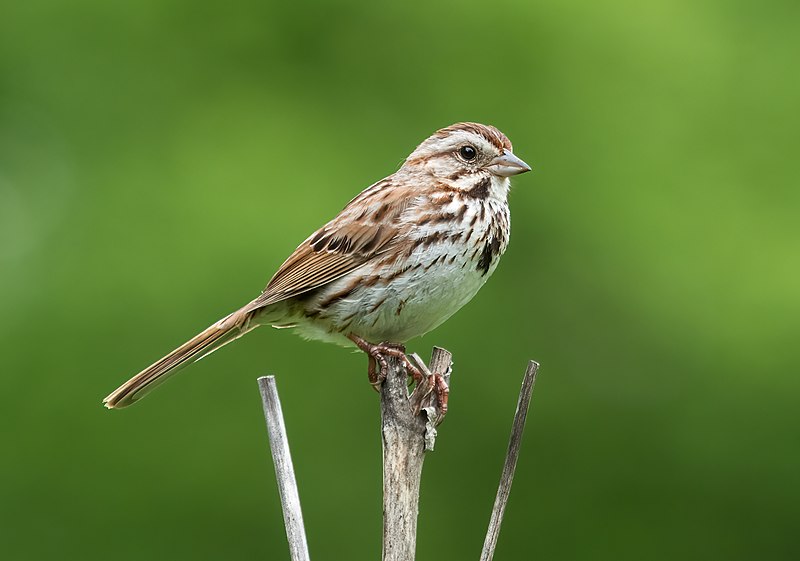
The Song Sparrow (Melospiza melodia) is a small yet abundant bird in North America.
They have brown upperparts with dark streaks and are white underneath, complete with a distinct dark brown spot on the breast.
Their cap is also brown, and long, rough feathers can be seen sprouting from their neck area.
This sparrow species is highly variable and adaptable to many environments, including dry brushland, wetlands, and open fields.
It has been noted that adult song sparrows will sing even during winter when other birds remain quiet.
These energetic little animals make great backyard companions as they sing their lovely melodies.
Scientific classification:
| Kingdom | Animalia |
| Phylum | Chordata |
| Class | Aves |
| Order | Passeriformes |
| Family | Passerellidae |
| Genus | Melospiza |
| Species | M. melodia |
27. American Crow
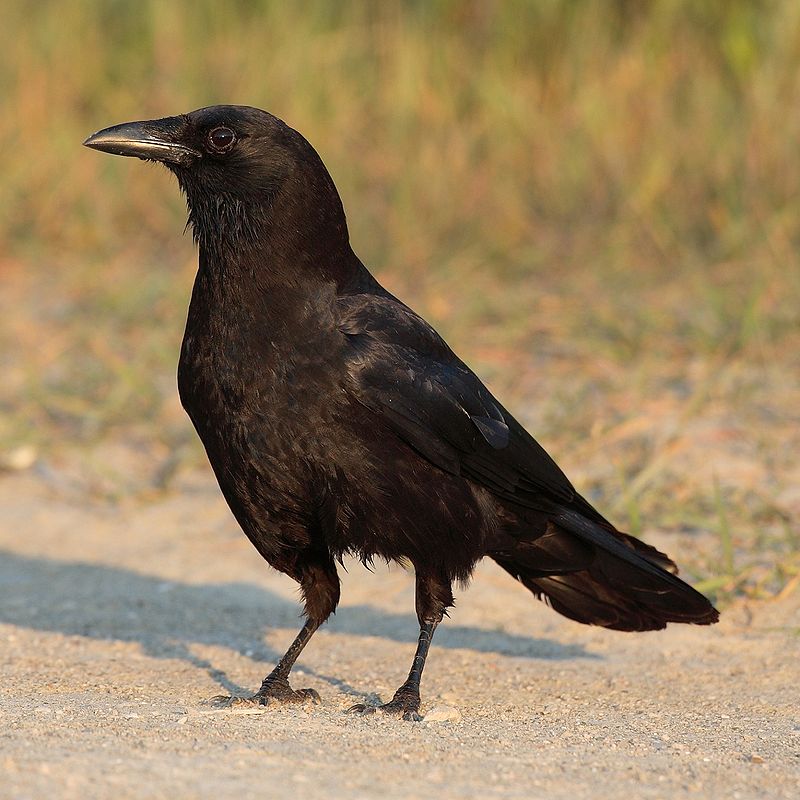
The American crow is a large bird of the Corvidae family, native to most parts of North America.
It is similar in size and structure to its European counterpart, the carrion crow and Eurasia’s hooded crow.
The three species occupy the same ecological niche but are distinguishable by their differences in appearance.
American crows have black feathers covering their entire body, with wingspans averaging between 17-21 inches wide for males and 16-19 inches for females.
They feed on insects such as grasshoppers, beetles, and caterpillars; they also eat grains from fields or abandoned farms during winter when food sources become scarcer.
In addition to feeding habits, American crows can be identified by their distinct call, which resembles a “caw” sound that travels long distances over open terrain, making them popular among birdwatchers.
Scientific classification:
| Kingdom | Animalia |
| Phylum | Chordata |
| Class | Aves |
| Order | Passeriformes |
| Family | Corvidae |
| Genus | Corvus |
| Species | C. brachyrhynchos |
28. Indigo Bunting
The Indigo Bunting is a small bird in the cardinal family throughout North and South America.
It has an unmistakable bright blue plumage that stands out against its natural habitat of farmland, brush areas, and open woodland.
During the breeding season, it can be seen from southern Canada to northern Florida, while during winter months, it migrates south towards Central and Northern South America.
The Indigo Bunting prefers to migrate at night using the stars as navigation aids.
This species feeds on insects and seeds they find near the ground or catch mid-flight with their agile wingspan.
An iconic sight for many farmers across both continents, these birds are a welcome addition to any backyard oasis or wildflower meadow.
Scientific classification:
| Kingdom | Animalia |
| Phylum | Chordata |
| Class | Aves |
| Order | Passeriformes |
| Family | Cardinalidae |
| Genus | Passerina |
| Species | P. cyanea |
29. Chipping Sparrow
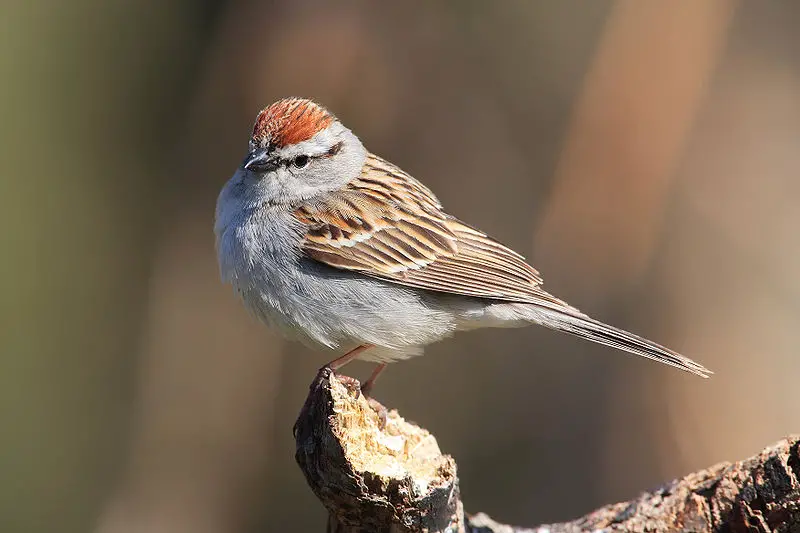
The Chipping Sparrow is a small passerine bird in most of North America. It has two subspecies, the eastern and western chipping sparrows, which migrate seasonally to overwinter in warmer climates.
The birds are grey above with white underparts, have a rufous cap with black stripes, and large eyes surrounded by light brown feathers.
They feed mainly on seeds but can also be seen eating insects during breeding season when raising their young chicks.
These intrepid little birds live in open grasslands such as prairies or meadows, building cup-shaped nests in trees or shrubs to raise their young family.
Their cheerful song often sounds like ‘chips,’ hence its name: Chipping Sparrow.
Scientific classification:
| Kingdom | Animalia |
| Phylum | Chordata |
| Class | Aves |
| Order | Passeriformes |
| Family | Passerellidae |
| Genus | Spizella |
| Species | S. passerina |
30. Common Grackle
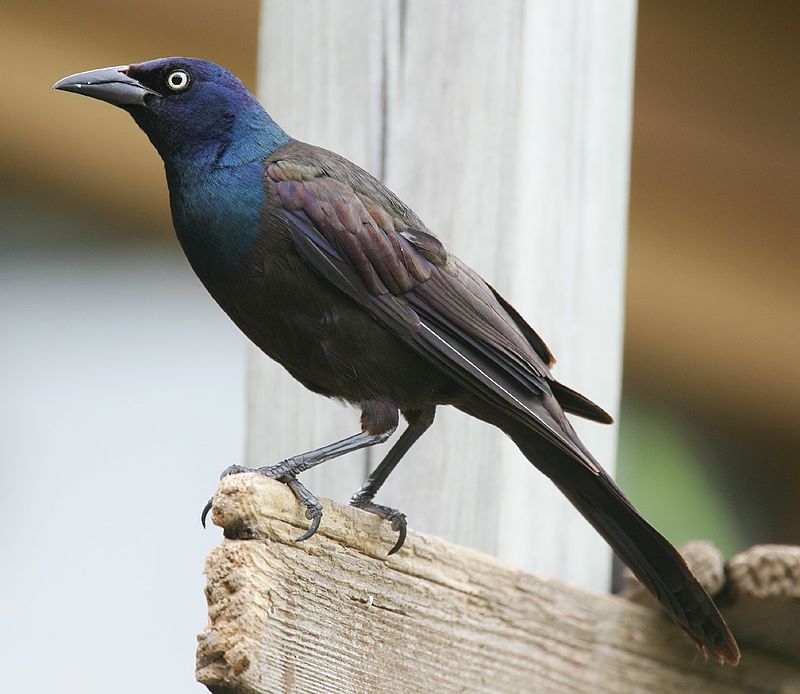
The Common Grackle is a large icterid bird commonly found in North America. It has an iridescent head and pale yellow eyes framed by its long dark bill and long tail.
Males typically have more vivid colors on their heads than females do. These birds can be seen across much of the continent, in fields, forests, wetlands – even urban areas.
They form huge flocks to search for food, such as grains or insects, that they catch with their bills.
If available, the grackles may also scavenge from human sources like garbage dumps or picnic tables. With its colorful plumage and distinct call, this species is easy to spot amongst other birds.
Scientific classification:
| Kingdom | Animalia |
| Phylum | Chordata |
| Class | Aves |
| Order | Passeriformes |
| Family | Icteridae |
| Genus | Quiscalus |
| Species | Q. quiscula |
31. Northern Mockingbird
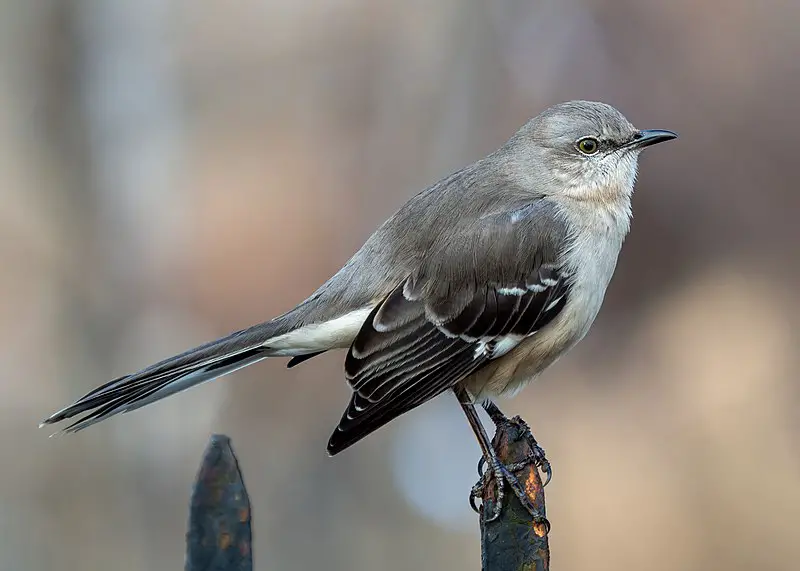
The northern mockingbird is a common fixture in North American skies. It has greyish-brown upperparts and a paler underside with white wing patches, and its distinctive long tail makes it easy to spot.
This adaptable bird can often be seen singing from the tops of trees or fences, though it rarely strays into Europe.
Carl Linnaeus first described the species in his 1758 Systema Naturae as Turdus polyglottos – aptly named for their remarkable ability to mimic other birds’ songs.
Northern mockingbirds typically live on insects, fruits, berries, and seeds, but they will also happily scavenge food scraps left out by humans.
This beloved avian contributes to our environment with its beautiful song and striking plumage.
Scientific classification:
| Kingdom | Animalia |
| Phylum | Chordata |
| Class | Aves |
| Order | Passeriformes |
| Family | Mimidae |
| Genus | Mimus |
| Species | M. polyglottos |
32. Blue Grosbeak
The Blue Grosbeak is a medium-sized North American passerine bird from the Cardinalidae family. It has striking plumage, with males showing off an impressive blue coloration and two brown wing bars.
Females are mainly brown with scattered blue feathers on the upperparts, but they also have two brown wing bars like males.
During summer, these birds can be found in northern Mexico and the southern United States, where they breed, while during wintertime, they migrate to Central America for resting purposes.
This beautiful bird species is easy to spot due to its vibrant colors, making it a popular sight amongst wildlife observers.
Scientific classification:
| Kingdom | Animalia |
| Phylum | Chordata |
| Class | Aves |
| Order | Passeriformes |
| Family | Cardinalidae |
| Genus | Passerina |
| Species | P. caerulea |
33. Summer Tanager
The Summer Tanager is a stunningly beautiful member of the cardinal family. Native to North and South America, this medium-sized songbird features striking red plumage on its back with yellow underparts.
It has a pointed black bill and long tail feathers that can be seen fluttering through the air when it flies.
The species’ vocalizations are quite similar to those of other members of its genus, which often include short whistles and chirps and longer songs of various phrases or syllables.
With their vibrant colors and melodic voices, these birds make an eye-catching sight any time they appear.
Scientific classification:
| Kingdom | Animalia |
| Phylum | Chordata |
| Class | Aves |
| Order | Passeriformes |
| Family | Cardinalidae |
| Genus | Piranga |
| Species | P. rubra |
34. New World Warblers
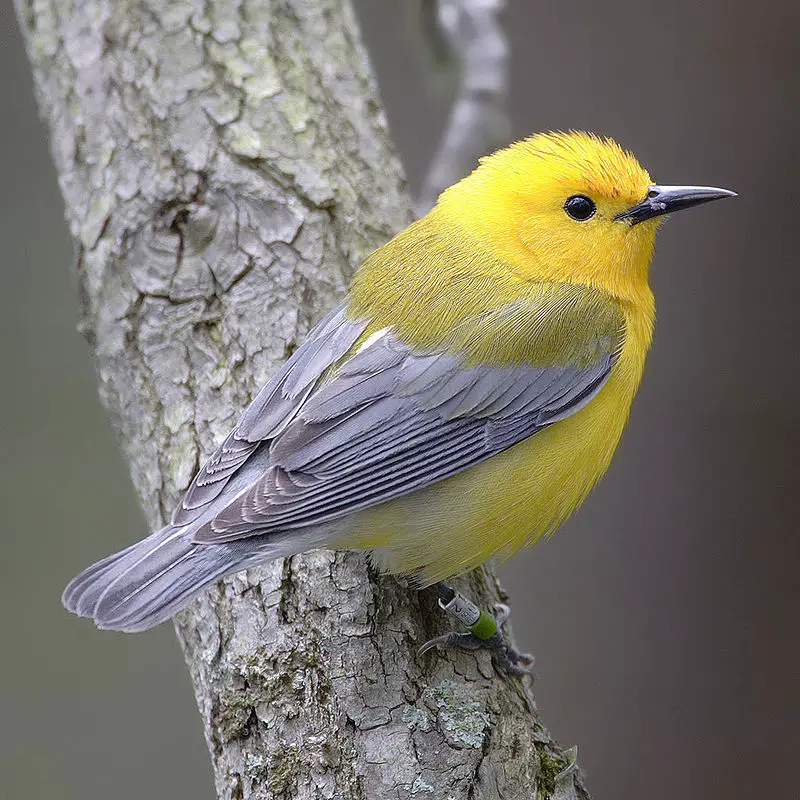
New World warblers are an incredibly diverse family of small birds found only in the Americas. They range in size from tiny hummingbirds to large thrushes and come in various vibrant colors.
All have thin bills for eating insects, which form their main diet. Most species live predominantly arboreal lives, meaning they spend most of their time among trees or bushes searching for food.
However, some members, such as ovenbirds and waterthrushes, prefer more terrestrial habitats like forest floors where they can scavenge for bugs on the ground instead.
Warblers provide a great source of entertainment with their beautiful songs, often filling up woodlands during mornings and evenings throughout springtime.
Scientific classification:
| Kingdom | Animalia |
| Phylum | Chordata |
| Class | Aves |
| Order | Passeriformes |
| Superfamily | Emberizoidea |
| Family | Parulidae Wetmore et al., 1947 |
35. Eastern Towhee
The Eastern Towhee is a large New World sparrow native to brushy areas of eastern North America. These birds have distinct black and white markings, with chestnut brown underparts.
They nest either low in bushes or on the ground beneath shrubs. Northern towhees are known for migrating south during the winter months.
In recent decades, taxonomy debates have left some questioning whether this bird should remain its species or be grouped with the Spotted Towhee as one species- The rufous-sided Towhee.
This lively songbird is bubbly and can often hop around on branches looking for food, such as insects, fruits, and seeds.
Scientific classification:
| Kingdom | Animalia |
| Phylum | Chordata |
| Class | Aves |
| Order | Passeriformes |
| Family | Passerellidae |
| Genus | Pipilo |
| Species | P. erythrophthalmus |
36. Orchard Oriole
The Orchard Oriole is a small species of icterid bird, with the subspecies I. s. Fuerte is sometimes considered a separate species known as the Ochre or Fuertes’ Oriole.
The adult male of the nominate subspecies has chestnut upperparts and black wings and tail, while females are more yellowish-green in coloration on their back and wings.
Its bill is pointed, black in color, with some blue-gray at the base of its lower mandible.
This beautiful bird can also be found across North America during migration season; they inhabit woodlands near streams or rivers to breed before migrating south for winter months.
Scientific classification:
| Kingdom | Animalia |
| Phylum | Chordata |
| Class | Aves |
| Order | Passeriformes |
| Family | Icteridae |
| Genus | Icterus |
| Species | I. spurius |
37. Painted Bunting
The Painted Bunting is an eye-catching bird from the Cardinal family, native to North America. Carl Linnaeus first described it in his eighteenth-century Systema Naturae.
The males of this species are particularly striking; they have brightly colored plumage, which only appears after their second year of life and can be distinguished from female birds through close inspection.
These colorful songbirds delight any avid birder, with their vibrant hues bringing joy to nature lovers everywhere.
They often inhabit woodland areas where plenty of seeds and insects are available for them to feed on – as well as some shrubbery so they can hide away safely when needed.
Scientific classification:
| Kingdom | Animalia |
| Phylum | Chordata |
| Class | Aves |
| Order | Passeriformes |
| Family | Cardinalidae |
| Genus | Passerina |
| Species | P. ciris |
38. Snowy Egret
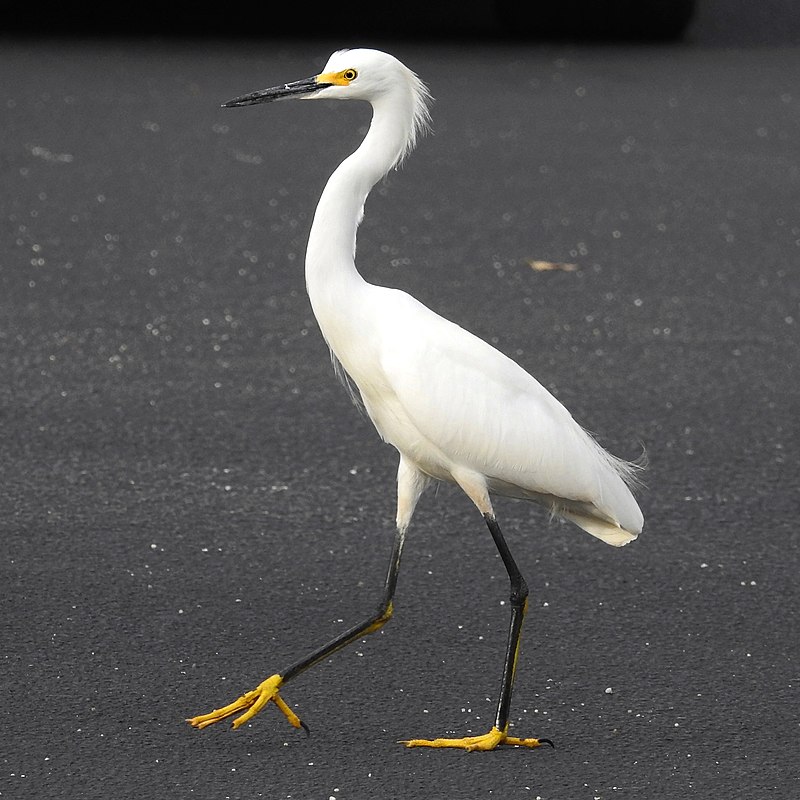
The Snowy Egret is a small white heron native to North America. Its scientific name, Egretta thula, comes from Provençal French for the little egret and an incorrect reference to the Black-necked Swan by Chilean naturalist Juan Ignacio Molina in 1782.
This beautiful bird has black legs, yellow feet, and a long plume of feathers on its head that often appears as if it’s wearing a crown.
It feeds primarily on insects and aquatic life like fish or frogs, making it well adapted for wetland habitats such as marshes or swamps and coastal areas close to shorelines.
Their graceful movements make them truly delightful creatures to observe while exploring nature.
Scientific classification:
| Kingdom | Animalia |
| Phylum | Chordata |
| Class | Aves |
| Order | Pelecaniformes |
| Family | Ardeidae |
| Genus | Egretta |
| Species | E. thula |
39. White-Crowned Sparrow
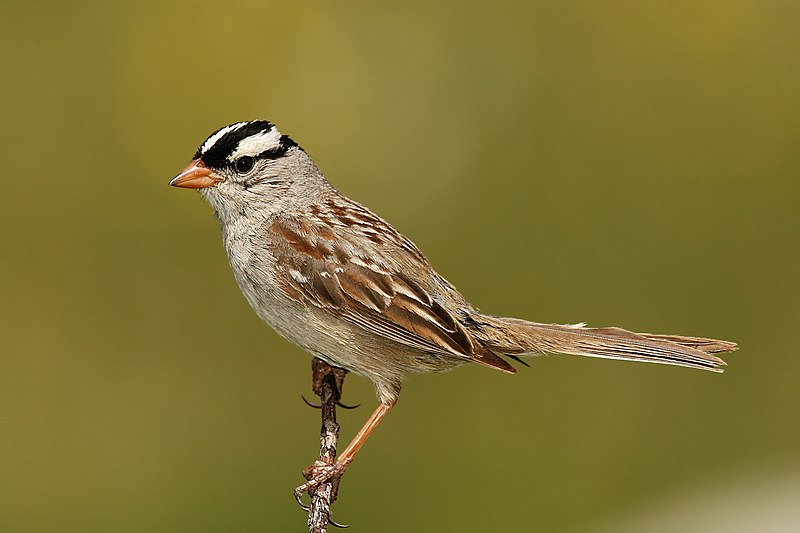
The White-crowned Sparrow is a species of passerine bird native to North America. It has a grey face and black and white streaking on its upper head, making it easy to identify.
This sparrow usually breeds in brushy areas in North America’s taiga, tundra, Rocky Mountains, or Pacific coast regions.
During winter, these birds migrate southward as far as Mexico and California, where they can live amongst chaparral shrubbery or low bushes near open fields with plenty of seeds nearby.
This bird’s diet consists mainly of insects during summer, while they switch over to eating grains like wheat & oats during colder months when bugs are scarce.
They are known for their characteristic chirp, which sounds like “Oh sweet Canada Canada,” drawing admirers worldwide.
Scientific classification:
| Kingdom | Animalia |
| Phylum | Chordata |
| Class | Aves |
| Order | Passeriformes |
| Family | Passerellidae |
| Genus | Zonotrichia |
| Species | Z. leucophrys |
40. Yellow-Headed Blackbird
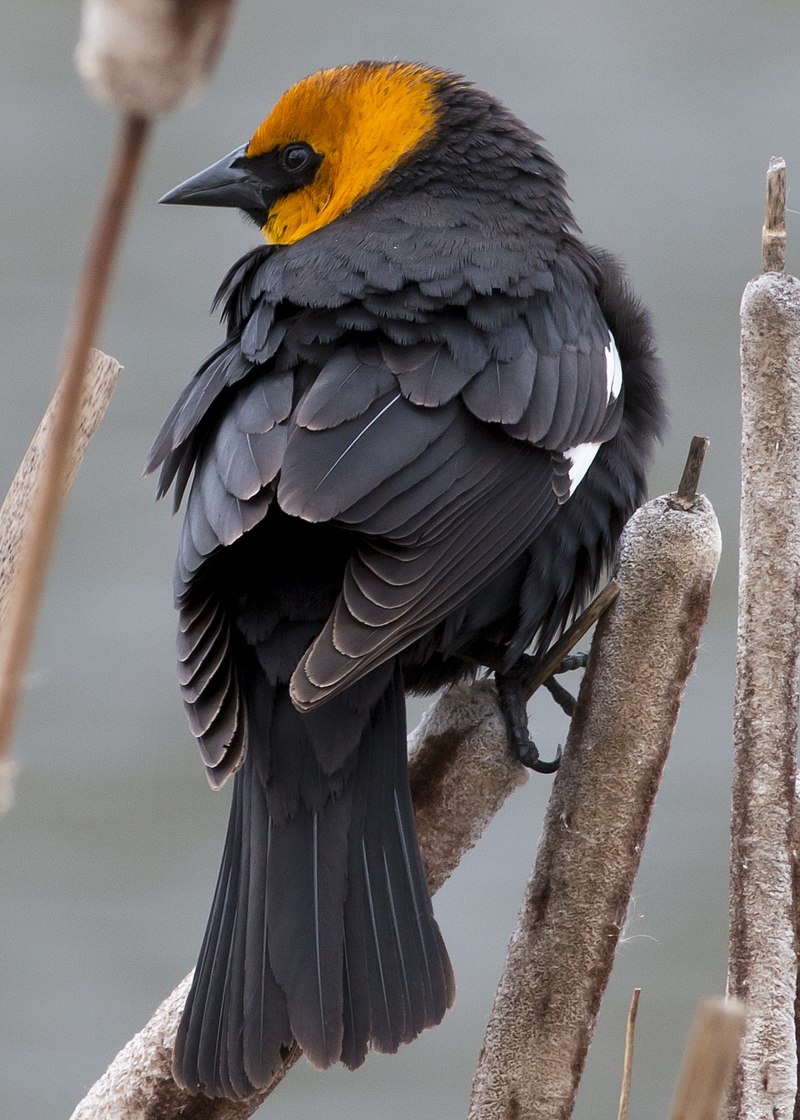
The yellow-headed blackbird is a medium-sized bird with striking features – its head and neck are bright yellow, while the rest of its body is black.
It has large eyes, a pointed bill, and long wings that help it soar.
The species gets its name from Greek words meaning ‘yellow’ (xanthous) and ‘head’ (cephalus).
This species can be found in wetlands across North America during summer, where they feed on insects and other invertebrates such as snails, earthworms, spiders, and crustaceans.
During winter, they migrate southward for food or when temperatures drop too low for comfort.
They also form flocks, making them more visible than solitary birds like hawks or owls. Yellow-headed Blackbirds make beautiful sounds that echo around wetland areas; these melodic calls bring joy to many nature lovers.
Scientific classification:
| Kingdom | Animalia |
| Phylum | Chordata |
| Class | Aves |
| Order | Passeriformes |
| Family | Icteridae |
| Genus | Xanthocephalus Bonaparte, 1850 |
| Species | X. xanthocephalus |
41. Wood Thrush
The Wood Thrush is a beautiful bird native to North America, closely related to the American Robin.
It has mottled brown and white upperparts with a spotted breast, buffy sides and flanks, and reddish-brown tail feathers.
This medium-sized thrush prefers wooded areas where it can find its favorite food – insects such as beetles, caterpillars, and spiders.
The male’s song is one of the most recognizable sounds in nature, an ethereal mix of flute-like whistles that often echo through forests on warm summer nights.
The Wood Thrush holds special status as the official bird of Washington D.C., making it even more beloved amongst residents who take pride in seeing this exquisite species up close.
Scientific classification:
| Kingdom | Animalia |
| Phylum | Chordata |
| Class | Aves |
| Order | Passeriformes |
| Family | Turdidae |
| Genus | Hylocichla Baird, 1864 |
| Species | H. mustelina |
42. American Redstart
The American Redstart is a beautiful New World Warbler, first documented by Carl Linnaeus in 1758.
An elegant black and orange plumage sets it apart from other birds.
The genus Setophaga comes from the Ancient Greek words ‘sēs,’ meaning moth, and ‘pages,’ which means eating, referencing its insect-eating habits.
Its song is joyful, with short repeating phrases making up their melodic tune.
They are mostly found hopping around trees on their long legs during breeding season but migrate to Central America for winter months when food sources become scarce in North America.
Scientific classification:
| Kingdom | Animalia |
| Phylum | Chordata |
| Class | Aves |
| Order | Passeriformes |
| Family | Parulidae |
| Genus | Setophaga |
| Species | S. ruticilla |
43. Dickcissel
The Dickcissel is a small migratory bird belonging to the Cardinalidae family. It breeds in the grasslands of the Midwestern US and winters in Central America, northern Colombia, and Venezuela.
Being the only member of its genus Spiza, it stands out from other birds with its distinctive song that sounds like “dick-sis-sel.”
These birds are quite attractive to watch with a light brown body, black streaks on their wings, and chestnut-colored shoulders and crowns.
They also have short bills while foraging through tall prairie vegetation or searching around fence posts for insects.
Although not endangered, their population has declined due to habitat loss caused by human development, so conservation efforts should be taken up soon.
Scientific classification:
| Kingdom | Animalia |
| Phylum | Chordata |
| Class | Aves |
| Order | Passeriformes |
| Family | Cardinalidae |
| Genus | Spiza Bonaparte, 1824 |
| Species | S. americana |
44. Turkey Vulture
The turkey vulture is a large bird of prey in many parts of the world. It has a wingspan of up to 6 feet, and its feathers are mostly black with brownish-red patches on the underside, which give it an overall dark red appearance.
Its head is bald, which helps protect it from getting overheated when flying long distances looking for food.
The Turkey Vulture usually feeds off carrion but will also feed on fruit and insects.
Its keen eyesight allows them to spot potential meals from miles away while they soar through the sky using their broad wings and thermal air currents to stay aloft without expending much energy.
They are very important scavengers as they keep ecosystems healthy by consuming dead animals before the disease can spread amongst living creatures or contaminate local water sources like rivers or lakes.
Scientific classification:
| Kingdom | Animalia |
| Phylum | Chordata |
| Class | Aves |
| Order | Accipitriformes |
| Family | Cathartidae |
| Genus | Cathartes |
| Species | C. aura |
45. Brown Thrasher
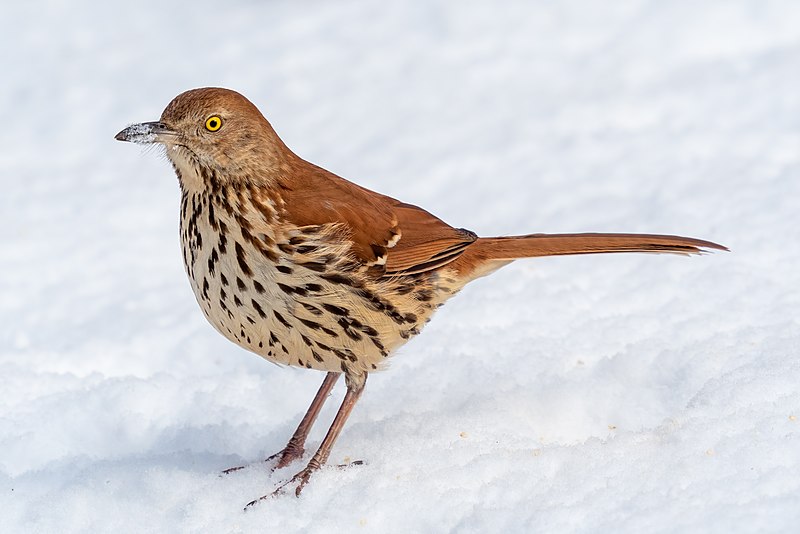
The brown thrasher is a member of the Mimidae family, along with catbirds and mockingbirds. It is found throughout much of North America in the eastern and central United States and southern and central Canada.
The only place it does not inhabit is west of the Rockies or Central Texas.
This bird can be identified by its reddish-brown back feathers, white underbelly, and long tail that often drags behind it when walking on the ground hunting for food like insects, fruits, or berries.
Its loud song consists of over 2000 different notes.
Brown Thrashers are known to build nests close to human activity, which makes them easily accessible for observation, making them a popular backyard species among many birdwatchers.
Scientific classification:
| Kingdom | Animalia |
| Phylum | Chordata |
| Class | Aves |
| Order | Passeriformes |
| Family | Mimidae |
| Genus | Toxostoma |
| Species | T. rufum |
46. Yellow-Rumped Warbler
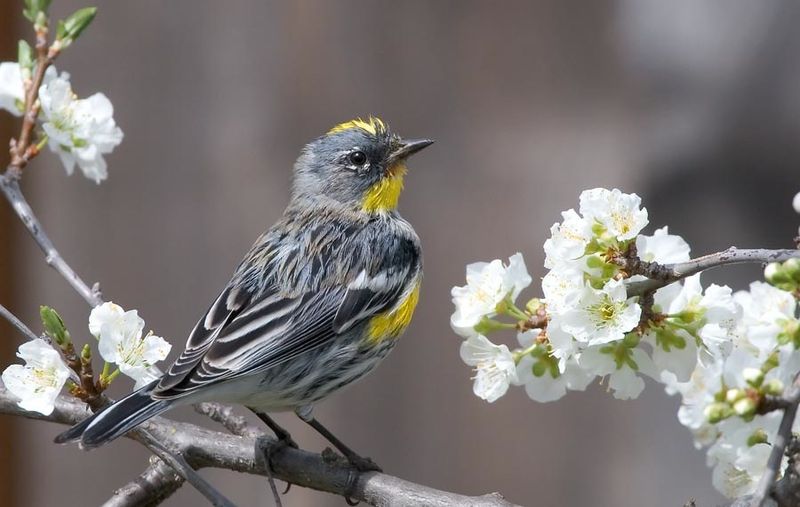
The Yellow-rumped Warbler (Setophaga coronata) is a migratory bird species found throughout North America.
It has an extensive range, from the Pacific and Atlantic coasts of the US to Canada and Central America, with a concentration in northern areas during the breeding season.
These birds migrate southwards for wintering grounds, where they find plentiful food sources such as insects and berries.
They are easily identified by their yellow patches on either side of their tails, white underparts, gray back feathers, and two distinct crown stripes.
One black or greyish-brown above the eyes extends towards its neck, banded in yellow or light brown.
Furthermore, these warblers have strong legs, which allow them to cling onto branches while hunting for prey, making them adept at maneuvering through tree cover quickly.
Altogether, this makes the Yellow-rumped Warbler an attractive backyard visitor year-round.
Scientific classification:
| Kingdom | Animalia |
| Phylum | Chordata |
| Class | Aves |
| Order | Passeriformes |
| Family | Parulidae |
| Genus | Setophaga |
| Species | S. coronata |
47. Blue-Gray Gnatcatcher
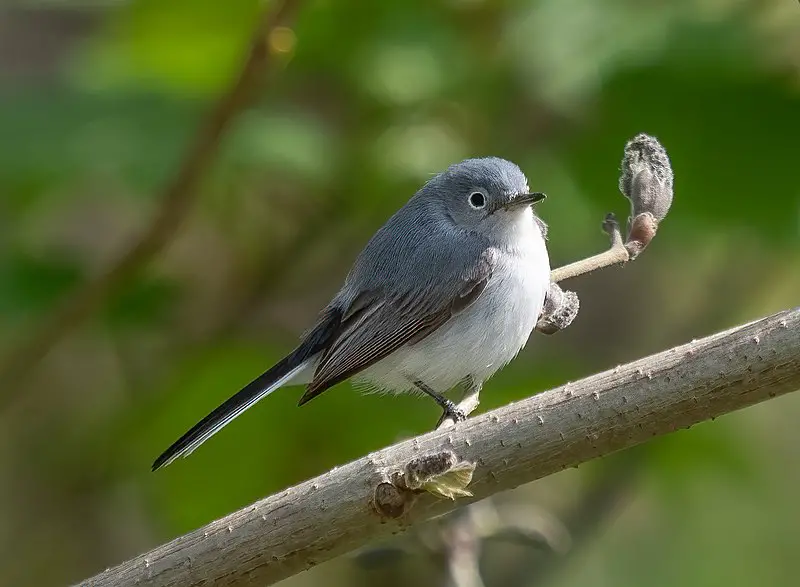
The Blue-gray Gnatcatcher is a beautiful small songbird native to North America. It has a length of 10–13 cm (3.9–5.1 in), a wingspan of 6.3 in (16 cm), and weighs only 5–7 g (0.18–0.25 oz).
Males have blue-gray upperparts with white underparts, slender dark bills, and long black tails edged in white; females are less vibrant but still eye-catching.
Juveniles are brownish-gray overall but may show some hints of adult coloration around their tails or shoulders as they mature into adulthood.
Their diet consists mainly of insects, which they catch while flitting through the air like tiny darts.
This stunning species can be found anywhere from woodlands to urban parks, so keep your eyes peeled for these delightful creatures on your next outdoor adventure.
Scientific classification:
| Kingdom | Animalia |
| Phylum | Chordata |
| Class | Aves |
| Order | Passeriformes |
| Family | Polioptilidae |
| Genus | Polioptila |
| Species | P. caerulea |
48. House Wren
The House Wren is a small bird of the Wren family found in Canada and South America. It’s quite common in suburban areas and is one of the most widely distributed native birds in North and South America.
Its taxonomy can be complicated, with some subspecies groups considered separate species.
The House Wren has a brown back, grey head, white eyebrow stripes, light chestnut belly, and buffy flanks.
They often inhabit old or abandoned buildings and shrublands near fields or open woods for nesting sites.
During the breeding season, they are highly territorial, so create an inviting environment if you wish to invite them into your yard.
Scientific classification:
| Kingdom | Animalia |
| Phylum | Chordata |
| Class | Aves |
| Order | Passeriformes |
| Family | Troglodytidae |
| Genus | Troglodytes |
| Species | T. aedon |
Conclusion
Missouri’s diverse landscapes provide habitats for various bird species, making it a haven for birdwatchers and nature enthusiasts alike.
From the vibrant plumage of the Northern Cardinal to the majestic flight of the Bald Eagle, the state offers opportunities to observe an array of resident, migratory, and wintering birds throughout the year.
Whether soaring above the forests, perched along rivers, or foraging in grasslands, these 48 birds represent just a glimpse of the avian diversity that enriches Missouri’s natural heritage.
Protecting and conserving these habitats is vital to ensure the continued presence of these feathered residents for generations to come.